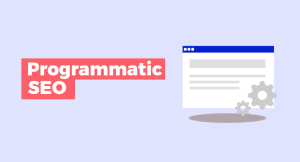In the ever-evolving world of digital marketing, Programmatic SEO is becoming a game-changer especially for businesses and publishers looking to scale their online presence quickly. But what exactly is programmatic SEO, and how can you use it to your advantage?
Let’s break it down in plain English, with real-life examples you can actually relate to.
🧠 What is Programmatic SEO?
Programmatic SEO is the process of generating a large number of web pages using data and templates to rank for long-tail keywords at scale.
Instead of writing every page manually, you use a programmatic (automated) approach to create hundreds or thousands of pages each targeting a unique combination of search keywords.
Think of it as creating “SEO landing pages” in bulk, automatically, with smart keyword targeting.
🚀 Why Use Programmatic SEO?
-
Scale quickly: Instead of creating 10 pages, you can create 1,000+ in days.
-
Target long-tail keywords: These are easier to rank for and have higher conversion potential.
-
Improve user experience: Serve highly relevant content based on specific queries.
-
Boost traffic: More indexed pages = more chances to show up on Google.
🧩 Key Components of Programmatic SEO
-
Keyword Research
-
Focus on long-tail, transactional, or location-based keywords.
-
-
Data Collection
-
Use structured data like spreadsheets, APIs, or databases.
-
-
Content Templates
-
Create reusable content frameworks with placeholders.
-
-
Automation Tools
-
Use scripts or CMS tools to auto-generate pages.
-
-
On-Page SEO
-
Optimize meta tags, headers, internal linking, and schema markup.
-
🛠️ Practical Examples of Programmatic SEO
🔹 Example 1: Travel Website
Imagine a travel website like TripAdvisor creating pages like:
-
“Best Hotels in Sydney for Couples”
-
“Best Hotels in Melbourne for Families”
-
“Best Hotels in Perth Near the Beach”
These pages follow the same template but serve unique combinations of keywords like:
“Best Hotels in [City] for [Traveler Type]”
With a city list and traveler type list, you can automatically generate hundreds of optimized landing pages.
🔹 Example 2: Job Portals
Job search platforms like Indeed or Seek use programmatic SEO by creating pages like:
-
“Marketing Jobs in Brisbane”
-
“Part-Time Jobs in Perth”
-
“Remote Developer Jobs in Australia”
Each of these pages is generated using job titles + locations + employment types = hundreds or thousands of pages targeting specific searches.
🔹 Example 3: E-commerce Platforms
An online store can create filtered landing pages using:
-
Product Category + Brand + Feature
For example:
-
“Men’s Running Shoes by Nike with Arch Support”
-
“LED TVs Under $500 in Sydney”
These combinations can be auto-generated based on data in your product feed or database.
🔹 Example 4: Local SEO Pages
A digital marketing agency might target local business owners with:
-
“SEO Services in Melbourne”
-
“SEO Services in Gold Coast”
Instead of creating each page manually, use a location list + service list to build these out via templates.
💡 How to Get Started with Programmatic SEO
Here’s a simplified roadmap:
✅ Step 1: Find Your Keywords
Use tools like:
-
Ahrefs
-
SEMrush
-
Google Keyword Planner
Focus on low competition, high intent, and long-tail terms.
✅ Step 2: Create Your Dataset
Gather structured data such as:
-
Cities
-
Product names
-
Service types
-
Attributes/features Use Excel, Airtable, or pull from your CMS/API.
✅ Step 3: Build Your Content Template
Create a single SEO-optimized content structure with variables like:
-
{City}
-
{Service}
-
{Product Feature}
Write sample content and identify areas you can automate or spin with dynamic content.
✅ Step 4: Use a CMS or Automation Tool
Options include:
-
Webflow with Make.com or Airtable
-
WordPress with custom post types and plugins
-
Headless CMS + scripts (for advanced users)
✅ Step 5: Optimize & Monitor
-
Add meta tags dynamically
-
Use internal linking to pass authority
-
Submit XML sitemaps to Google Search Console
-
Monitor page performance with Google Analytics & GSC
⚠️ Common Pitfalls to Avoid
-
Thin content: Don’t just copy-paste variables. Add real value!
-
Duplicate pages: Each page must offer unique relevance.
-
Neglecting quality control: Use logic rules to avoid broken or irrelevant combinations.
-
Over-indexing: Don’t publish thousands of pages overnight. Stagger the rollout.
📈 Success Stories of Programmatic SEO
-
Zapier: Generated thousands of pages for app-to-app integrations (e.g., “Connect Gmail to Trello”).
-
NerdWallet: Created dynamic content comparing financial products by city and purpose.
-
GlobalGenie.com.au: Web design and SEO services company that creates dynamic local landing pages for each major city in Australia (e.g., “Affordable Website Design Gold Coast”).
These businesses drive millions of organic visitors through smart, scalable SEO.
🎯 Final Thoughts
Programmatic SEO isn’t just for tech giants. With the right approach, even small businesses and niche sites can dominate long-tail keywords, improve visibility, and grow traffic without manually building every page.
The trick is to combine smart data, solid templates, and real SEO value.
Whether you run a service business, an e-commerce store, or a local directory, programmatic SEO can become your most powerful (and efficient) growth engine.



